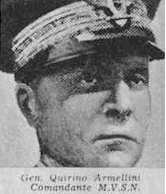Template:Use dmy dates Template:Short description
| General Quirino Armellini | |
|---|---|
 Armellini depicted as commander of the MVSN. | |
| Born | January 31, 1889 |
| Died | January 13, 1975 (aged 85) |
| Place of birth | Legnaro, Province of Padua |
| Place of death | Rome |
| Allegiance |
|
| Service/branch |
|
| Years of service | 1908–1952 |
| Rank | Army corps general |
| Battles/wars |
Italo-Turkish War World War I Second Italo-Ethiopian War World War II |
| Awards |
Military Order of Savoy Order of Merit of the Italian Republic |
| Other work |
Commander of the Voluntary Militia for National Security (MVSN) Member of the Italian resistance movement |
Quirino Armellini (31 January 1889 in Legnaro – 13 January 1975 in Rome) was an Italian military officer, who served as a general in both the Royal Italian Army and the Italian Army.
Biography
Armellini was commissioned into the Royal Italian Army as a second lieutenant in 1908, after graduating from the Military Academy of Modena,[1] and participated in the Italo-Turkish War and the World War I.[2]
After serving under the command of Pietro Badoglio in the Second Italo-Ethiopian War against the Ethiopian Empire, Armellini was appointed commander of the Italian African Police (PAI) in the Italian East Africa (AOI).[3]
In 1942, during the World War II in Yugoslavia, Armellini was appointed commander of the XVIII Army Corps in the Italian-occupied Dalmatia.[4]
After the fall of the Fascist regime in Italy on 25 July 1943, King Victor Emmanuel III appointed Armellini to succeed Benito Mussolini as commander of the Voluntary Militia for National Security (MVSN), the paramilitary wing of the National Fascist Party (PNF). Under his leadership, the MVSN was dissolved and integrated into the regular Royal Army.
From January to March 1944, when it (Giuseppe Cordero Lanza di Montezemolo) was arrested, Armellini assumed the role of head of the it (Fronte militare clandestino) of the it (Resistenza romana) within the Italian resistance movement, later replaced by it (Roberto Bencivenga).
After the World War II, Armellini was president of the Superior Council of the Italian Armed Forces.[5]
See also
References
- ↑ (in Italian) Gazzetta Ufficiale del Regno d’Italia n.37, 14 febbraio 1908, pag.760.
- ↑ "Quirino Armellini (Dizionario Biografico)" (in Italian). http://www.treccani.it/enciclopedia/quirino-armellini_(Dizionario_Biografico)/.
- ↑ "Quirino Armellini" (in Italian). https://books.google.it/books?id=v5WFsimZUQ4C&pg=PA15&lpg=PA15&dq=generale+Quirino+Armellini&source=bl&ots=Ii9_c6qhvB&sig=ntF8-qyGDrmHVJVyUJb1N4KOrfc&hl=it&sa=X&ei=IcrLT_3EC83qOe7L9fkP&ved=0CD8Q6AEwAzgK#v=onepage&q=generale%20Quirino%20Armellini&f=false.
- ↑ Talpo, Oddone (1990). Ufficio Storico Stato Maggiore dell’Esercito. ed (in Italian). Dalmazia Una cronaca per la storia 1942. pp. 1428.
- ↑ "Quirino Armellini nell’Enciclopedia Treccani" (in Italian). http://www.treccani.it/enciclopedia/quirino-armellini/.
External links
- http://www.generals.dk/, ed. "Quirino Armellini". http://www.generals.dk/general/Armellini/Quirino/Italy.html. Retrieved 9 January 2020.
Template:Authority control